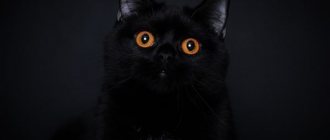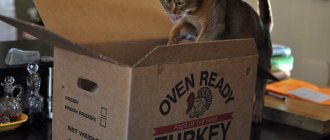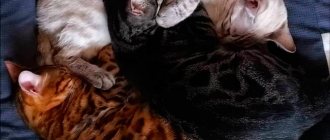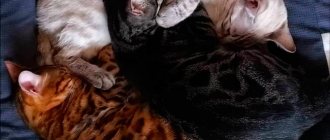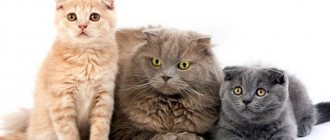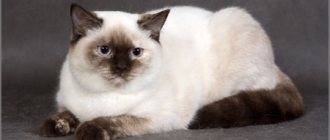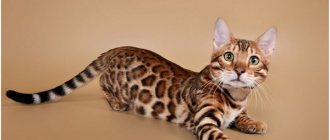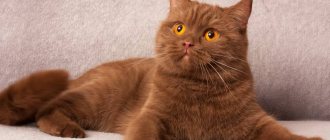Spotted color
The spotted color of the Bengal cat is the most popular color. If you have seen a Bengal cat, then most likely you have seen it in its spotted form. The brown spotted tabby color was recognized in Championship Status (TICA) in 1991.
Spotted Bengals have distinctive, small to medium-sized spots along the entire length of their body. Large, random, two-color rosettes are especially appreciated. This color in domestic cats looks like a mini-leopard. This style emerged when breeders believed that larger, sparser spots were more desirable. The original spotted tabby pattern found in domestic cats has been modified by selective breeding.
The coat is covered with random, diagonal or horizontally aligned spots on the body, belly and legs. Large dark spots on a light background are usually preferable.
Of course, there are variations in spotting, and one Bengal cat can have many different types of spots.
Single-Spotted
The spots are monochrome, one-color. These are simply solid spots splashed with droplets on a contrasting background, similar to wild cats such as Cheetahs or hybrid spotted cats (Ocicat, Egyptian Mau, Spotted Shorthair).
Bengals with solid spots are allowed to show, but are not preferred. Some breeders believe that they should not be allowed to compete.
The most popular spotted color for a Bengal cat is the Rosette Bengal. Spots are called rosettes when the spots are two-tone contrasting colors different from the background color. The Bengal cat is the only domestic cat with rosettes!
Rosettes in the Bengal breed began in the early 2000s, when some breeders bred the shade spots with darker spots. The rosette quickly developed.
When you see the evolution of the breed over the years, it is amazing to realize the progress that some rosette breeders have made in just a few decades.
The 3 most important types of socket:
— Arrows (Arrow-head) — Paw-print — Donut (Donut)
Arrowhead sockets
The arrows may be solid and monochrome in one spotted group, or they may be a variety of colors that fade toward the background. Well-defined arrow rosettes are rare and popular among Bengal cat owners and breeders.
The arrowhead socket is not the most common, but it is probably the easiest type of socket to identify. Arrow rosettes are shaped like a triangle, like the tip of an arrow or teardrop, with all ends pointing toward the back of the cat.
Asian leopard cats have many different color types, but the arrowhead pattern is one of the most visually impressive. Arrow-shaped spots are excellent camouflage in the dim light of a forest habitat. With such fur, a cat that stands motionless on trees or in fallen leaves is very difficult to notice.
The Bengal cat breed standard requires the spots to be horizontally aligned instead of the vertically aligned spots of the classic tabby. The arrow-shaped spots on the coat give them the appearance of illusory movement or motion blur.
Donut outlets
Donut rosettes are spots darker than the main background, outlined by an even darker outline.
The donut rosette gets its name from the almost complete dark outline around a lightly colored center.
It took years of selective breeding to create the donut-shaped rosettes, but they are now one of the most popular rosettes.
Paw-print rosettes
Paw print rosettes are shaded spots that are open on one side with smaller, darker spots on the edge. Such a rosette is never completely covered by a dark outline.
Footprint rosettes get their name because they often look like small paw prints running across a cat's body.
Smoked sockets
Smoke rosettes are large, full rosettes that seem to fit together like a puzzle with little space in between.
Chain socket
Chain rosettes are a linked series of donut rosettes connected horizontally and running parallel on either side of the cat's spine.
The chain rosette can also be seen on wild cats such as Ocelots.
Clusters of rosettes
Rosette clusters are small spots that form clusters around a central color.
Phasing in Bengal kittens
The spectacular color characteristic of Bengals does not appear immediately after birth. The pattern on a kitten's fur is unknown even at the time of moving to a new home. The babies are covered with thin hairs of a white, gray or red hue with a non-distinctive pattern. Up to a year, a Bengal cat can resemble a simple yard striper.
The phasing effect confuses buyers, because at the time of purchase the main qualities of the breed are hidden and you can only trust the reputation of the breeder.
The kitten's bright appearance is hidden due to phasing, which serves as a natural camouflage. The baby's coat begins to change at the age of 12-15 weeks, and ends no earlier than 7 months. The lighter the background of the coat, the sooner the camouflage disappears, while dark merle colors appear slowly. However, watching your pet grow brings pleasure, as the Bengal is transforming every day. By the age of 2, the beauty of a purebred Bengal cat is fully revealed.
Among the colors of the Bengal you can find both bright patterns and restrained tones. The diversity of the wild palette, combined with some unpredictability, makes the Bengal cat breed attractive to lovers of natural beauty.
join the discussion
Share with your friends
Bengals are one of those unique cat breeds that are considered highly sought after due to their distinctive and striking appearance and unique character traits. The breed first appeared in the States, where a wild Asian leopard cat was crossed with a regular short-haired cat. Europeans were able to see such a wild cat for the first time in the northeast of South Asia - in a historical region called Bengal, where the name of this magnificent breed came from.
The main difference that the modern breed has is the unique leopard pattern, which helps the color of the animals to be considered unique. Bengal cats received this kind of feature from their distant ancestors living in the wild. The coat of representatives of this breed has a very beautiful and even shine, which becomes especially noticeable in bright sunshine.
Marble color
The marbled pattern is formed from “liquid” spotted stripes swirling in a whirlwind. The ideal marbled Bengal cat has a horizontally flowing, random, asymmetrical structure consisting of swirls of two or more colors.
The marbled Bengal cat has four official types: reduced horizontal flow, horizontal flow, chaotic pattern and leaf marble patterns.
In 1987, Gene Mill (Millwood Cattery) released the first marbled Bengal kitten, a cat named Millwood Painted Desert:
She was an impressive little female with a strange, soft, creamy color and a strange pattern that looked like an ice cream caramel. At the Incats show at Madison Square Garden, and all over the country, she was a sensation!
In his first standard for the Bengal breed, Jean Mill did not intend to include anything other than spots. But Painted Desert was an instant success with both the judges and the public, and so the marble was included in the Bengal breed registry.
Descendants from these early marbled Bengals contributed to the description of the gene and horizontal flow that produced the first "rosette" spots in the 2000s.
In 1993, the merle color of the Bengal breed was included in championship status within the TICA.
Bonus: Marble Spot or Sparbl
)
Do you think that spotted and marbling patterns have never been seen before?
Look at the coloring where the spots and marbling merge. "Sparbling" is not actually an official color, but is used in the breeder's dictionary to describe Bengals that have both rosette and merle markings.
Sparble is considered a spotted Bengal cat, not a marbled cat.
Now that we have looked at the different patterns that Bengal cats have, let's look at the colors of the Bengal cat.
Like other cat breeds, Bengals come in a variety of colors. There are about 6 colors of the Bengal cat, divided into standard and non-standard by the International Cat Association (TICA).
Standard Bengal colors:
— brown (gold) — snowy — silver
Unrecognized colors:
— coal (charcoal) — blue — melanistic (black)
Yes, these are standard cat colors. But, of course, the complex beauty of the Bengal cat is not only 6 color options. No. The Bengal breed has many more colors and shades. But, regardless of color, the pattern on a Bengal cat should provide a high degree of contrast.
Classification Features
Experts today identify 3 main colors characteristic of this breed: brown (almost golden), silver and 3 more rich snow colors. Within any of these color shades, there are 2 generally recognized types of patterns: spots and marbling. There are special tables that can be used to easily determine the color of a Bengal and describe the characteristics of its color.
Any designation of the color of a cat’s fur has a number of groups.
- The name of the breed itself is 3 capital English letters.
- The name of the base color is 1 or 2 lowercase letters, while the second s means silver color, the second y means golden (n is the black color of the breed, ns is the black smoky color, ny is black with gold).
- The minor part of the current index will be specified if necessary and will consist of two numbers. The first is the type of the very trait that is being described, for example, the color of the eyes or the presence of white spots on the coat, and the second number characterizes the trait itself.
Many people identify the correct color of Bengals by number:
- From “0” – the presence of white coloring in the coat;
- C “1” – tipping size for the silver group of the breed;
- With “2” – the type of pattern of the tabby breed;
- With “3” – highlighting the type of color of the point group;
- C “5” – expression of tail length (if tail anomalies are present);
- With “6” is the eye color, it is indicated when the colors may differ.
Brown (golden) Bengal cat
The brown (or golden) Bengal (C,C color genes) is the most popular of the Bengal cats, and was the first cat to be recognized by TICA in 1983.
Traditional brown Bengals have green or gold eyes.
The background color can vary from a gray-brown tone to a bright orange-gold.
The color of the spots, rosettes, or marbles can range from black/light brown to darker or reddish brown.
If you have a brown furry friend, you probably know that brown comes in a variety of shades such as: gold, cream, dance, honey, taupe, dance, beige, caramel, cinnamon.
All shades of brown are acceptable, but orange-brown is preferred for the main background color of the coat.
As you can see, almost all shades of brown are available for the Bengal breed.
Now, if you look at a brown (golden) Bengal, you will notice the following characteristics:
- Brown tail with a black tip - Pink nose - Brown, copper, gold, green or brown eyes - White belly preferred
Magnificent creatures, aren't they?
Types of drawings
If, when breeding this breed, breeders strive to bring the appearance of cats as close as possible to the original (wild) one, then in terms of colors they have long conquered even nature itself. First of all, it is necessary to mention here those pets from whom the Bengal received all the best for its breed. Abyssinian cats allowed us to add warm tones of apricot to the background of the Bengal fur. Burmese cats have passed on their unique coloring called sepia.
The Siamese lightened the body, while leaving the bright points dark and much more contrasting. Mau from Egypt donated her silver and bronze color. American cats with short hair gave the breed a marbled color. The result was a surprisingly bright and beautiful cat.
Snow Bengal cat
Looking for Mini Bars? Then this is the cat you are looking for.
Unlike the name, they are not completely white Bengal cats.
In fact, the Snow Bengal color comes in 3 genetically different colors (and names):
— Snowy Sepia — Snowy Lynx — Snowy Mink
It can be difficult to tell the difference between these three colors. A genetic test is always the best method for differentiating the 3 snow bengals. Alternatively, eye color can help determine the Bengal's snow color.
Snow Lynx (color genes Cs, Cs) has:
- Very light white cream color - Dark or light markings - Dark tail tip - Blue eyes. Always.
Snow Mink (color genes Cb, Cs) has:
- Ivory, cream, light-tan - Various shades of markings from light beige to dark beige or coffee - Dark tail tip - Blue-green or aquamarine eyes
Snow Sepia (color genes Cb, Cb) has:
- Ivory, cream, light-tan - Various shades of markings from light coffee to dark - Dark tail tip - Green or gold eyes
Not so bad, right? Isn't it too difficult now to determine which Bengal color you want?
Silver Bengal cat
Silver (I,I inhibitory genes) is more of a color deficiency. This gene blocks any warm colors and produces an almost white background that contrasts with the bright dark markings. Silver color was added to the TICA Championship in 2004 for the Bengal breed.
Silver Bengal cats come in a variety of shades with backgrounds ranging from white to a very dark, steely color.
Silver can also be found in any other color combination: Snow Silver, Charcoal on Silver, Blue Silver, etc.
Silver Bengal has:
- As little yellow and brown as possible in color - Dark gray to black markings - Black tip of tail - Brick red nose - Green or gold eyes
It should be easy to tell which cats are silver!
Features of glitter in representatives of the black subspecies of the Bengal breed
Bengals with dark ash-colored or completely black coats are particularly suited to the famous elite glitter. On coats covered with a contrasting pattern, the shine, which turns into shine in bright light, is less noticeable, while on clean, unticked hair it covers the Bengal with sheer magic. The source of this phenomenon, to put it simply, is the presence of translucent and sometimes hollow hairs. When the rays hit them, they are refracted and produce not even shine, but radiance. Experts in the field of felinology explain the process with two interesting versions:
- Glitter is controlled by one of the recessive genes (which is why glitter does not always appear). When activated, it leads to a special grouping of pigment granules in the tips of the hairs. According to this hypothesis, the texture of the hair does not change.
- Proponents of another explanation believe that the source of the shine is the same recessive gene, which gives the coat a soft silkiness. In its homozygous manifestation, it makes the pigment granules dotted along the entire length of the hair. As a result, voids with tiny air bubbles appear inside. They are the ones who capture and transform the light flux.
It doesn't matter who ends up being more accurate in explaining the sparkle effect, but glitter is a delightful addition to the already chic appearance of charcoal and black Bengal cats.
Having set the goal of breeding a breed that would have the characteristic appearance of wild forest cats, but at the same time have a balanced, gentle character, man developed not hybrid, but cultivated varieties of Bengal cats. They differ from other purebred pets from the cat family not only in their temperament, but also in the variety of coat colors ranging from white to black, and most importantly, in completely unique patterns on their fur coats. Among them, the most exotic and so far rare are the charcoal and black bengals. Now that the study of the cat genome has taken advantage of identification using DNA tests, it is possible to more accurately control the coloring, tabby structure of cats, and the breeding of individual subspecies in one breed.
Charcoal (Charcoal) Bengal cat
The Charcoal Bengal (Ab, a or Apb, Apb color genes) is darker than the traditional recognized Bengal colors. The black, smoky charcoal color was especially noticeable in the early generations of F1 and F2 Bengals.
The Charkoal trait is inherited regardless of color, and can be exhibited in every color class: brown, silver, snow (Lynx Charkoal, Mink Charkoal, Sepia Charkoal) and even blue.
Charcoal Bengals have a dark gray or charcoal background with some (not red) and very dark spotted or marbling patterns.
The Charkoal may also have a darker face mask and a thick stripe, commonly referred to as the "Zorro mask". The mask resembles an inverted letter "Y".
The Charcoal Bengal's mask can be very dark, eventually matching the color of the black body markings.
The tail is dark brown/black or grayish-black with stripes and a black tip.
Blue Bengal cat
Blue color (d, d dilute genes) is very rare, but some breeders are working hard to try to promote blue Bengals to championship status.
Blue Bengal cats are blue-gray in color with cream tones. Mottled or marbled pattern - dark blue or metallic gray.
Since this is a regenerative gene, both parents must be blue to produce a blue Bengal cat.
Blue Bengals also have:
- Steely blue background color - Blue markings that never turn black - Dark gray tail - Gold, green or brown eyes
Black (Melanistic) Bengal cat
Black Bengals (a, a color genes) have black patterns on a black background that remind us of the melanistic color variant of leopards and jaguars: the black panther.
The background and pattern colors are the same in Bengal Melanistic. Their patterns are called "ghost markings" or "ghost spots" because they are barely noticeable. But you will still be able to see the pattern in daylight, just like on a black panther.
Black Bengals are rare and less popular among breeders as these color variations are frowned upon by associations.
As for the spots, they can be faint, dark brown to black, and can sometimes only be seen in natural sunlight.
The Smoky Bengal is a silver melanistic variation.
If you are looking for a black mini panther, this Bengal cat color will be your best choice!
Common colors
Of the huge number of types of colors, nature gave these small wild predators only one - “black spotted tabby”, and it is ideal for high-quality camouflage in a wild environment. The coat can have colors from delicate sand and gray to the darkest chestnut - this depends on the cats’ habitat. At the same time, the process of hybridization brought its own changes to the Bengal breed, and very interesting varieties appeared in the standards.
The TICA standard distinguishes 5 different colors. All of them, according to genetics, are black in color, but due to the increased degree of rufism, the color of cats often looks like yellowish-brown, leopard. That's why these colors are called:
- brown spotted marble tabby;
- silver spotted marble tabby;
- seal sepia spotted marble tabby;
- seal mink spotted marble tabby;
- seal spotted marble lynx-point.
In all of the above colors, experts allow the 2 types of patterns described above. In addition, a number of standards take into account blue colors. In this case, there can be combinations of all 4 listed colors and 2 patterns with silver wool.
Sometimes breeders produce completely black cats (melanistic), chocolate-colored kittens, and even lilac cats with tortoiseshell colors.
But these colors are not yet considered correct, therefore such cats are not used for breeding.
It is the brown tabby that is considered the original variety of the modern Bengal breed. The wild cat Malaysia once had a similar color, which was crossed with the Abyssinian black cat. The spots and stains (and plain ones too) in their descendants can be completely black, with a transition to a dark chocolate shade, or brick-brown, and even with a yellowish-brown tint.
Glitter (Shine)
Do you want a magic cat? Glitter is your golden ticket—literally.
Bengals are the first domestic cat to have glitter. But not all Bengals are glittery!
You may see the glitter in a shimmering, sparkling effect on your cat's fur. Even in low light you can see the sparkle of the glitter on the Bengal.
But what is this glitter, glitter?
“Glitter” is a translucent, hollow hair shaft that catches light and reflects it. It is present throughout your cat's fur.
It is truly a beautiful and wonderful sight. Who knew cats could be even more magical?
Bengal colors
The Bengal cat breed offers a range of incredible colors and patterns similar to those found in the wild.
Let's list them all with this infographic illustrating all the colors and patterns of the Bengal cat:
You can find the cheetah in the brown spotted color, the leopard and jaguar in the brown color, the snow leopard in the silver or snow color, and the black panther in the melanistic color.
Almost all big cats have miniatures represented in this magnificent cat breed.
There are two types of Bengal cats: spotted and marbled.
The spots may appear as rosettes or dots.
Marble patterns appear as elongated, spotted stripes and are a rarer pattern among Bengals.
When it comes to Bengal cat colors, just like your typical cat, they come in a wide variety.
You have browns and oranges, you have creams and whites, silvers, blacks, blues and charcoal.
There are many bengal cat hybrids out there and you can't help but love them all!
Character of the breed
Outwardly similar to small panthers, many traits in the Bengal's character were inherited from the habits of its wild ancestors:
- They are independent, freedom-loving, but very attached to their owner and show dog loyalty. They suffer from long separation.
- They do not like to lie in their arms for long periods of time; they climb onto their laps of their own accord when they want to pamper themselves.
- They quickly find contact with children and willingly participate in joint games and fun.
- They do not show aggression when the child accidentally or intentionally hurt the kitten. Just avoid the game and hide in a safe place.
- They do not show excessive communication or trust in unfamiliar people. It’s not easy for a stranger to stroke or caress them.
- They live freely, without conflicts, with other animals and inhabitants of the house.
- Playful and inquisitive, they love to climb cabinets, curtains, and sit on a hill.
- With affection and perseverance, Bengals can be trained, taught to use the toilet and flush the water from the tank.
- Representatives of the breed are successful hunters. There are no mice in the house where they live.
